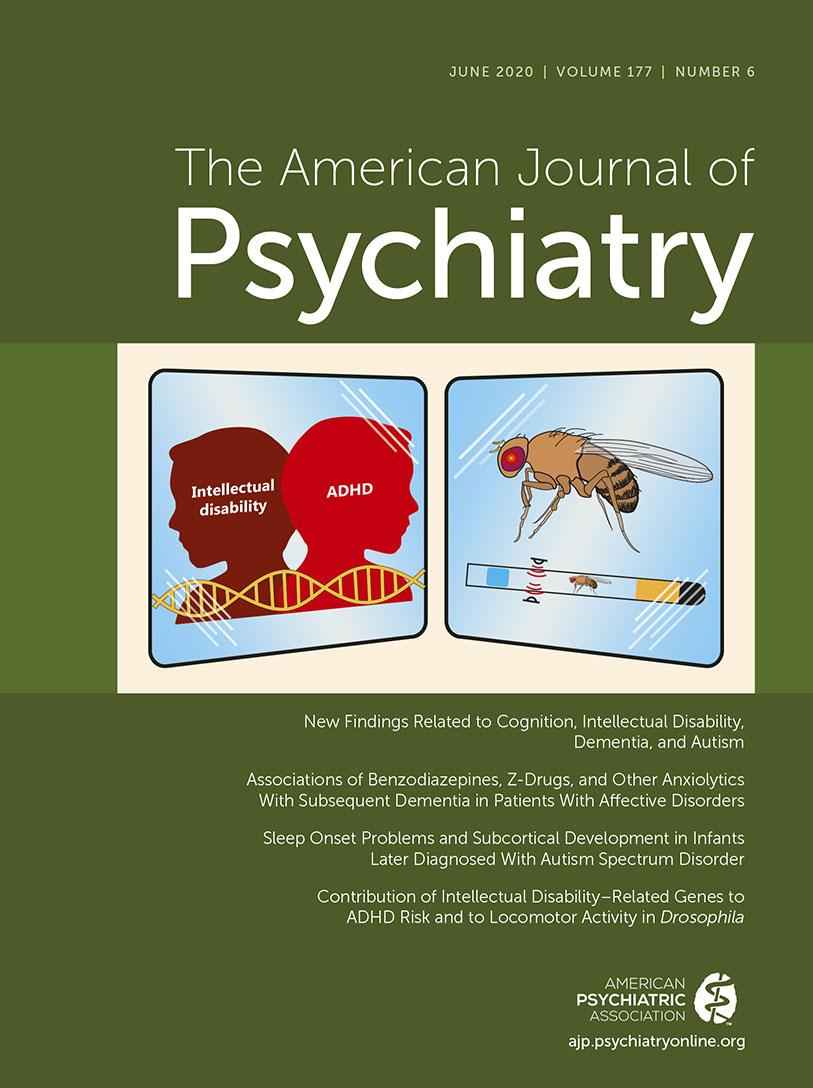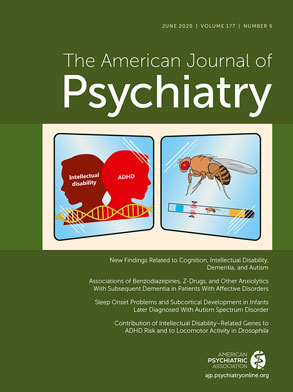This issue of the
Journal presents very interesting articles with new and important findings that are relevant to a variety of disorders, including autism, age-related memory impairment, dementia, attention deficit hyperactivity disorder (ADHD), and schizophrenia. Cognition and neurodevelopment are broad themes that cut across these articles, as do issues pertinent to the safe and effective use of benzodiazepines and antidepressants. In his overview for the
Journal (
1), Dr. Phil Harvey, an expert in neurocognition from the University of Miami Miller School of Medicine, thematically links and synthesizes the findings from these diverse but interrelated articles.
The first article in this issue, by Osler and coauthors (
2), provides compelling data that demonstrate a lack of association between the use of benzodiazepines and hypnotic Z-drugs with the development of dementia. In this very large study, subjects from the Danish National Patient Registry with affective disorders were selected, and information on their medication use was obtained. Patients with affective disorders were intentionally used for the study population, as depression has been associated with the development of dementia and has been identified as a potential confounding variable in other studies examining the relation between benzodiazepines and dementia. In the sample of more than 200,000 patients, 75.9% had used benzodiazepines and/or Z-drugs, and importantly, these individuals were not found to have a significantly greater likelihood of developing dementia. Additionally, the data suggest that the amount of usage of these drugs was not associated with dementia risk. These findings are obviously relevant because of the common use of benzodiazepines and Z-drugs, and in his editorial, Dr. Carl Salzman from Harvard Medical School addresses how these findings relate to earlier reports of possible deleterious effects of benzodiazepines. He also speculates about the possible neuroprotective effects of these agents and addresses their use in the elderly population (
3).
Because benzodiazepines can be highly effective for anxiety and their use in clinical practice has become controversial, I asked Dr. Jerry Rosenbaum, from Massachusetts General Hospital, to write a commentary updating our readership on the pros and cons of benzodiazepine use. Dr. Rosenbaum is uniquely suited for this as he is an expert in the treatment of mood and anxiety disorders, and he was involved with the initial studies establishing the efficacy of benzodiazepines in panic disorder. It is noteworthy that, despite current resistance on the part of physicians to prescribe benzodiazepines, data derived from the 2015 and 2016 National Survey on Drug Use and Health demonstrated that 12.6% of the population reported taking benzodiazepines in the past year (
4). In his commentary (
5), Dr. Rosenbaum provides a historical perspective on benzodiazepine use, nicely frames the current debate between advocates and opponents of benzodiazepines, and offers a rational strategy for the pharmacological treatment of anxiety disorders with cognitive-behavioral therapy, selective serotonin reuptake inhibitors (SSRIs) and serotonin-norepinephrine reuptake inhibitors, and benzodiazepines.
The next article in this issue, by Vega et al. (
6), demonstrates a lack of a linkage between prenatal antidepressant or SSRI exposure and the risk to develop autism. It is notable that the analytic methods used in this article markedly increase the confidence of the findings, which have significant implications for the treatment of depression during pregnancy. Here, Vega and colleagues demonstrate that the risk of developing autism following prenatal antidepressant exposure appears to be significantly increased when compared with the general population; however, this finding does not hold when more appropriate comparison groups are used. Specifically, no increased risk of developing autism was found when female psychiatric patients who did not receive prenatal antidepressants were compared with those who did take antidepressants. In addition, the authors also examined studies that used a discordant-sibling design (one sibling had prenatal exposure to antidepressants, and the other did not), and these data suggested that prenatal antidepressant administration during the first trimester might actually decrease the risk of developing autism. In their editorial (
7), Drs. Susan Maloney, Cynthia Rogers, and John Constantino from Washington University School of Medicine emphasize the clear public health importance of this result and point to the strength of this finding as resulting from the use of appropriate comparator groups and the inclusion of analyses with discordant siblings, which controls for genetic background.
In another article related to the risk of developing autism spectrum disorder (ASD), MacDuffie et al. (
8) studied high- and low-risk infants and report the observation that sleep onset problems between 6 and 12 months of age are more likely to occur in children who subsequently develop autism. This is consistent with other findings demonstrating sleep alterations in older children and adults with autism. Interestingly, the authors found that these sleep problems were also selectively related to hippocampal development and not that of other subcortical structures reported to be affected in autism subjects. In high-risk children who developed autism, sleep onset problems were associated with increased hippocampal volume as assessed across the first 2 years of life. This association between sleep and hippocampal development was not observed in high-risk infants who did not develop autism. The authors speculate that early-life sleep alterations could affect hippocampal development as an antecedent to ASDs, but this phenomenon was not tested.
The next article, by Klein et al. (
9), uses an innovative translational neuroscience approach that combines human genomic data with mechanistic models in the fruit fly (
Drosophila melanogaster) to identify novel genes potentially involved in the pathophysiology of ADHD. Because of the commonalities shared between intellectual disabilities and ADHD and existing knowledge about the relatively strong effects of specific genes in the development of intellectual disabilities, these investigators started with genes known to be involved with intellectual disabilities. From there, they identified a subset of the intellectual disability–related genes that also have been associated with ADHD (i.e.,
MEF2C,
ST3GAL3, and
TRAPPC9). Two of these genes were found to be conserved in
Drosophila, and elegant molecular methods were used in the flies to test the genes’ functional relevance. Results demonstrated the capacity to transform normal flies into those with “ADHD-like” behavioral features by knocking down the expression of
MEF2C selectively in dopamine neurons and
TRAPPC9 in dopamine and circadian neurons. These exciting findings are reviewed in an editorial by Caline Karam, Lilian Coie, and Jonathan Javitch from Columbia University. They highlight the innovative strategy used in the article by Klein et al., explaining the molecular methods used in this informative translational fruit fly model, and by so doing, they illuminate the importance of understanding molecular mechanisms in relation to new treatment development (
10).
The final two articles in this issue have implications for understanding individual differences in cognitive ability in relation to brain structure and in enhancing cognitive function in individuals with “age-related” cognitive changes. In the first of these articles, Holleran et al. (
11) use data from the ENIGMA consortium (Enhancing Neuro Imaging Genetics Through Meta Analysis) to examine the relation between microstructural white matter integrity, fractional anisotropy (FA), and IQ in a large group of healthy participants (N=957) and in patients with schizophrenia (N=760). The intent of this study was to uncover brain alterations related to the cognitive deficits known to be associated with schizophrenia. However, the results revealed that both global and tract-specific measures of FA were modestly but significantly and positively associated with IQ regardless of whether the individuals suffered from schizophrenia. While not specific to schizophrenia, these findings point to the strength of examining brain structural connectivity in relation to IQ. Although this correlational result does not address the issue of mechanism, the finding provides an important insight that is pertinent to understanding individual differences in IQ performance across the population.
The final article in this issue, by Lenze and coauthors (
12), tests whether established computerized interventions for age-related cognitive decline can be enhanced with vortioxetine administration. One hundred individuals 65 years or older with age-related cognitive decline, excluding subjects with dementia or mild cognitive impairment, were entered into the study. All subjects received cognitive training for 26 weeks and were randomly assigned to also receive either vortioxetine (10 mg/day) or placebo throughout the duration of the study. The SSRI vortioxetine was selected because of its unique properties, including antagonism of postsynaptic 5-HT
3 and 5-HT
7 receptors that are thought to underlie its putative procognitive effects. Although vortioxetine had effects that were significantly greater than placebo overall, this effect was primarily observed at the 12-week time point, with vortioxetine-related increases in cognition at the other time points not reaching statistical significance. Drs. Jason Smucny and Cameron Carter from the Department of Psychiatry at the University of California, Davis, discuss the implications of this potentially exciting finding as it relates to the neural systems that may underlie successful attempts to mitigate age-related cognitive decline (
13). Additionally, they suggest investigating other possible strategies to augment cognitive training such as neuromodulation methods, including frontal cortical transcranial direct stimulation.
In sum, this issue of the Journal presents some very exciting and important findings that provide insights into mitigating age-related cognitive decline, the relation between intellectual disabilities and ADHD, and an intriguing relation between sleep alterations during infancy, hippocampal development, and autism. This issue also presents new reliable evidence that addresses critical public health issues: no significant association between benzodiazepine use and the development of dementia, and no true significant association between prenatal antidepressant use and the development of autism.

